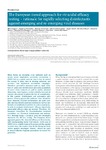The European tiered approach for virucidal efficacy testing – rationale for rapidly selecting disinfectants against emerging and re-emerging viral diseases
Eggers, Maren
Schwebke, Ingeborg
Suchomel, Miranda
Fotheringham, Valerie
Gebel, Jürgen
Meyer, Bernhard
Morace, Graziella
Roedger, Hans Joachim
Roques, Christine
Visa, Pilar
Steinhauer, Katrin
When facing an emerging virus outbreak such as severe acute respiratory syndrome coronavirus 2 (SARS-CoV-2), a quick reaction time is key to control the spread. It takes time to develop antivirals and vaccines, and implement vaccination campaigns. Therefore, preventive measures such as rapid isolation of cases and identification and early quarantine of cases’ close contacts—as well as masks, physical distancing, hand hygiene, surface disinfection and air control—are crucial to reduce the risk of transmission. In this context, disinfectants and antiseptics with proven efficacy against the outbreak virus should be used. However, biocidal formulations are quite complex and may include auxiliary substances such as surfactants or emollients in addition to active substances. In order to evaluate disinfectants’ efficacy objectively, meaningful efficacy data are needed. Therefore, the European Committee for Standardisation technical committee 216 ‘Chemical disinfectants and antiseptics’ Working Group 1 (medical area) has developed standards for efficacy testing. The European tiered approach grades the virucidal efficacy in three levels, with corresponding marker test viruses. In the case of SARS-CoV-2, disinfectants with proven activity against vaccinia virus, the marker virus for the European claim ‘active against enveloped viruses’, should be used to ensure effective hygiene procedures to control the pandemic.

